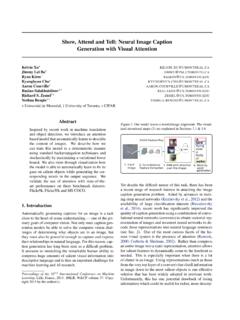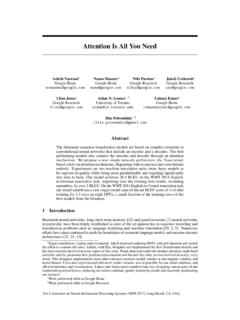Transcription of Show, Attend and Tell: Neural Image CaptionGeneration …
1 show , Attend and tell : Neural Image CaptionGeneration with Visual AttentionKelvin Lei S. by recent work in machine translationand object detection, we introduce an attentionbased model that automatically learns to describethe content of describe how wecan train this model in a deterministic mannerusing standard backpropagation techniques andstochastically by maximizing a variational lowerbound. We also show through visualization howthe model is able to automatically learn to fix itsgaze on salient objects while generating the cor-responding words in the output sequence.
2 Wevalidate the use of attention with state-of-the-art performance on three benchmark datasets:Flickr8k, Flickr30k and MS IntroductionAutomatically generating captions of an Image is a taskvery close to the heart of scene understanding one of theprimary goals of computer vision. Not only must CaptionGeneration models be powerful enough to solve the com-puter vision challenges of determining which objects are inan Image , but they must also be capable of capturing andexpressing their relationships in a natural language. Forthis reason, caption generation has long been viewed asa difficult problem.
3 It is a very important challenge formachine learning algorithms, as it amounts to mimickingthe remarkable human ability to compress huge amounts ofsalient visual infomation into descriptive the challenging nature of this task, there has beena recent surge of research interest in attacking the imagecaption generation problem. Aided by advances in trainingneural networks (Krizhevsky et al., 2012) and large clas-sification datasets (Russakovsky et al., 2014), recent workFigure model learns a words/ Image alignment. The visual-ized attentional maps (3) are explained in section & Input Image2.
4 ConvolutionalFeature Extraction3. RNN with attentionLSTM4. Word by word14x14 Feature Mapover the imagegenerationAbird flying over a body of water has significantly improved the quality of caption genera-tion using a combination of convolutional Neural networks(convnets) to obtain vectorial representation of images andrecurrent Neural networks to decode those representationsinto natural language sentences (see Sec. 2).One of the most curious facets of the human visual sys-tem is the presence of attention (Rensink, 2000; Corbetta &Shulman, 2002). Rather than compress an entire Image intoa static representation, attention allows for salient featuresto dynamically come to the forefront as needed.
5 This isespecially important when there is a lot of clutter in an im-age. Using representations (such as those from the top layerof a convnet) that distill information in Image down to themost salient objects is one effective solution that has beenwidely adopted in previous work. Unfortunately, this hasone potential drawback of losing information which couldbe useful for richer, more descriptive captions. Using morelow-level representation can help preserve this working with these features necessitates a power-ful mechanism to steer the model to information importantto the task at this paper, we describe approaches to caption genera-tion that attempt to incorporate a form of attention [ ] 11 Feb 2015 Neural Image Caption Generation with Visual AttentionFigure over time.
6 As the model generates each word, its attention changes to reflect the relevant parts of the Image . soft (top row) vs hard (bottom row) attention . (Note that both models generated the same captions in this example.)Figure of attending to the correct object (whiteindicates the attended regions,underlinesindicated the corresponding word)two variants: a hard attention mechanism and a soft attention mechanism. We also show how one advantage ofincluding attention is the ability to visualize what the model sees . Encouraged by recent advances in caption genera-tion and inspired by recent success in employing attentionin machine translation (Bahdanau et al.)
7 , 2014) and objectrecognition (Ba et al., 2014; Mnih et al., 2014), we investi-gate models that can Attend to salient part of an Image whilegenerating its contributions of this paper are the following: We introduce two attention -based Image caption gen-erators under a common framework (Sec. ): 1) a soft deterministic attention mechanism trainable bystandard back-propagation methods and 2) a hard stochastic attention mechanism trainable by maximiz-ing an approximate variational lower bound or equiv-alently by REINFORCE (Williams, 1992). We show how we can gain insight and interpret theresults of this framework by visualizing where and what the attention focused on.
8 (see Sec. ) Finally, we quantitatively validate the usefulness ofattention in caption generation with state of the artperformance (Sec. ) on three benchmark datasets:Flickr8k (Hodosh et al., 2013) , Flickr30k (Younget al., 2014) and the MS COCO dataset (Lin et al.,2014).2. Related WorkIn this section we provide relevant background on previouswork on Image caption generation and attention . Recently,several methods have been proposed for generating imagedescriptions. Many of these methods are based on recur-rent Neural networks and inspired by the successful use ofsequence to sequence training with Neural networks for ma-chine translation (Cho et al.)
9 , 2014; Bahdanau et al., 2014;Sutskever et al., 2014). One major reason Image CaptionGeneration is well suited to the encoder-decoder framework(Cho et al., 2014) of machine translation is because it isanalogous to translating an Image to a first approach to use Neural networks for caption gener-ation was Kiros et al. (2014a), who proposed a multimodallog-bilinear model that was biased by features from the im-age. This work was later followed by Kiros et al. (2014b)whose method was designed to explicitly allow a naturalway of doing both ranking and generation. Mao et al.
10 (2014) took a similar approach to generation but replaced afeed-forward Neural language model with a recurrent Vinyals et al. (2014) and Donahue et al. (2014) useLSTM RNNs for their models. Unlike Kiros et al. (2014a)and Mao et al. (2014) whose models see the Image at eachtime step of the output word sequence, Vinyals et al. (2014)only show the Image to the RNN at the beginning. AlongNeural Image Caption Generation with Visual Attentionwith images, Donahue et al. (2014) also apply LSTMs tovideos, allowing their model to generate video of these works represent images as a single feature vec-tor from the top layer of a pre-trained convolutional net-work.



![arXiv:0706.3639v1 [cs.AI] 25 Jun 2007](/cache/preview/4/1/3/9/3/1/4/b/thumb-4139314b93ef86b7b4c2d05ebcc88e46.jpg)

![arXiv:1301.3781v3 [cs.CL] 7 Sep 2013](/cache/preview/4/d/5/0/4/3/4/0/thumb-4d504340120163c0bdf3f4678d8d217f.jpg)
![@google.com arXiv:1609.03499v2 [cs.SD] 19 Sep 2016](/cache/preview/c/3/4/9/4/6/9/b/thumb-c349469b499107d21e221f2ac908f8b2.jpg)





![arXiv:1810.04805v2 [cs.CL] 24 May 2019](/cache/preview/1/9/9/d/f/4/1/e/thumb-199df41e75ddced4fcbe49402e2275e7.jpg)